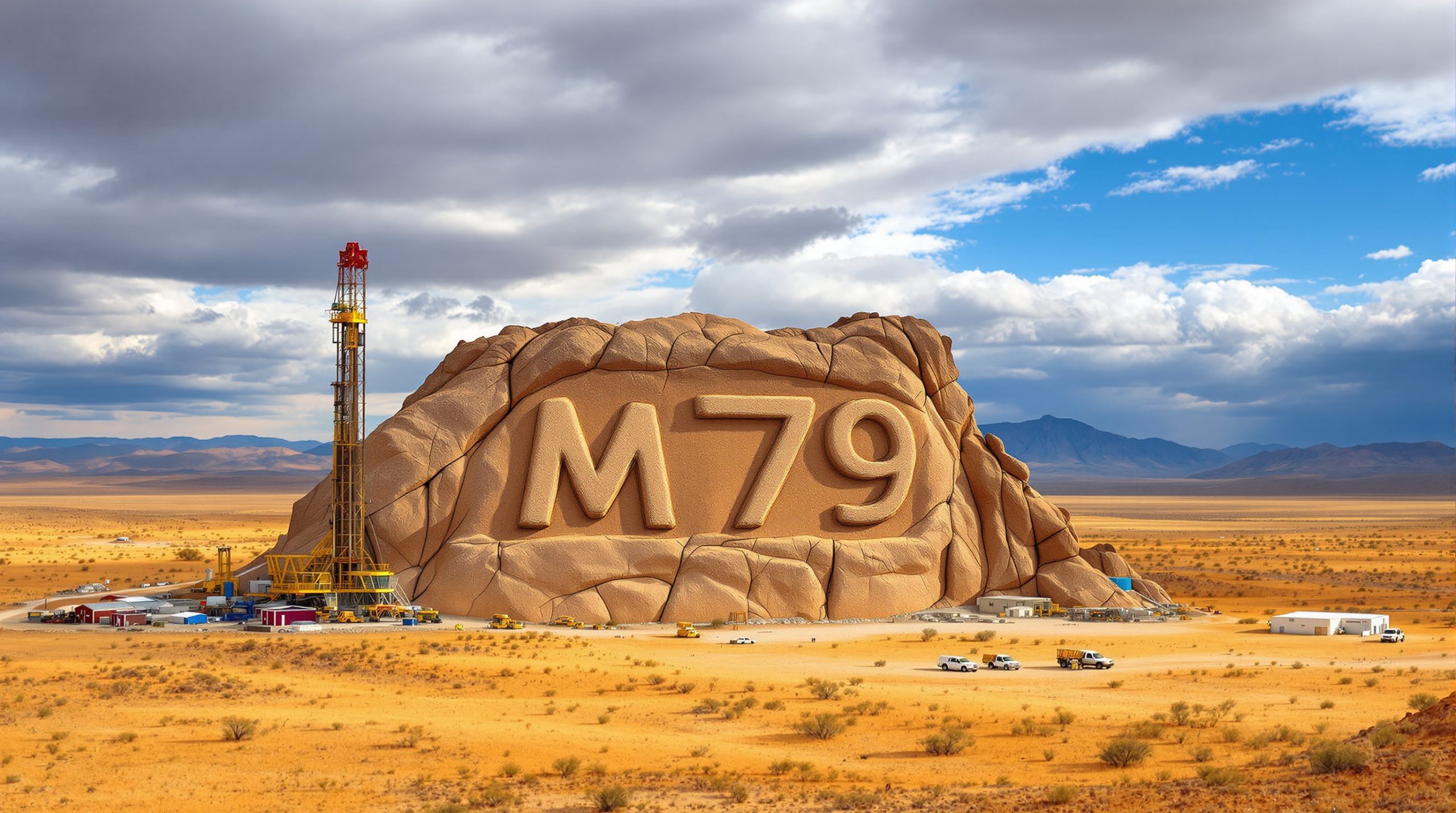Mammoth Minerals Unveils Massive Intrusive Complex at Excelsior Gold Project
Mammoth Minerals Limited (ASX: M79) has announced major findings from its high-resolution magnetic survey at the flagship Excelsior Gold Project in Nevada, revealing a significant 5.5km x 4.2km intrusive complex with striking similarities to the famous Goldfield Caldera that has produced 4.2 million ounces of gold. Furthermore, this mammoth minerals gold project discovery positions the company's project as a compelling exploration target with substantial upside potential.
Game-Changing Magnetic Survey Results
The comprehensive property-wide magnetic survey has delivered exceptional results that could reshape the project's exploration trajectory. Moreover, these findings have significantly expanded the understanding of the geological system beneath the property.
Key Discoveries:
- Massive intrusive complex identified north of the Buster Trend, measuring 5.5km x 4.2km
- Extensive lithological and structural variation indicating a long-lived system with multiple overprinting intrusion events
- High concentration of historical workings on the margins of the intrusion, suggesting previous prospector interest
- Multiple skarn-type targets identified within and proximal to the intrusive complex
- Extended geological strike length of the Buster Trend to 7.3km (up from previous estimates)
Additionally, the survey has provided unprecedented detail of the subsurface geology, revealing structural complexities that were previously unrecognised.
Managing Director Glenn Poole commented: "The high-resolution magnetics survey completed recently across Excelsior has really underlined the significance of our ground position and its enormous prospectivity. Such a large intrusive complex with significant structural and lithological complexity is similar to that of the Goldfield Caldera, 35 kilometres to the north-east, which hosts 4.2Moz of previous production."
The Goldfield Caldera Connection
What makes this mammoth minerals gold project discovery particularly compelling is its analogous setting to the nearby Goldfield Caldera, located just 35km northeast of Excelsior. The Goldfield district represents one of Nevada's most successful gold mining areas, having produced 4.2 million ounces of gold throughout its history.
However, the geological similarities extend beyond mere proximity. The structural complexity and intrusive characteristics observed at Excelsior mirror those that have made Goldfield such a prolific gold producer.
Comparative Analysis:
| Feature | Excelsior Intrusive Complex | Goldfield Caldera |
|---|---|---|
| Size | 5.5km x 4.2km | Comparable scale |
| Distance | Primary location | 35km northeast |
| Geological Setting | Multiple intrusion events | Proven gold system |
| Production | Exploration stage | 4.2 million oz Au |
| Structural Complexity | High variation | Multiple ore zones |
Consequently, the similarities in geological setting and structural complexity suggest that Mammoth's discovery could host comparable mineralisation systems.
Understanding Intrusive Complexes: Why This Matters for Gold Exploration
What is an Intrusive Complex?
An intrusive complex forms when molten rock (magma) is injected into existing rock layers over extended periods, creating multiple overlapping intrusion events. These systems are particularly important for gold exploration because they often create the heat and chemical conditions necessary for gold mineralisation.
Furthermore, the scale of the identified system at Excelsior indicates a long-lived magmatic process that could have generated multiple episodes of mineralisation.
Why Multiple Intrusion Events Matter
- Extended mineralisation periods – longer time for gold-bearing fluids to form deposits
- Structural complexity – creates multiple pathways for mineralising fluids
- Diverse target types – can host various styles of gold mineralisation
- Large-scale systems – potential for multiple ore zones across significant areas
The presence of skarn-type targets is particularly encouraging, as these contact metamorphic zones between intrusive rocks and surrounding formations are known to host high-grade gold and copper deposits worldwide. In addition, these systems often occur in clusters, suggesting multiple exploration opportunities within the complex.
Expanding the Buster Trend: 7.3km of Prospective Geology
The magnetic survey has extended the known geological strike length of the Buster Trend to 7.3km, representing a significant expansion of the prospective area. This is particularly noteworthy given that drilling to date has only evaluated 1.1km of this total strike extent – just 15% of the newly defined prospective geology.
Exploration Opportunity:
- Current drilling coverage: 1.1km (15% of trend)
- Remaining unexplored strike: 6.2km (85% of trend)
- Expansion potential: 560% increase in prospective geology
Consequently, this expansion represents a substantial increase in the exploration potential of the project. For instance, if the remaining 85% of the trend contains similar mineralisation to the tested portions, the resource potential could increase dramatically.
Active Exploration Programs Gaining Momentum
Mammoth has identified substantial surface disturbances and historical workings across the intrusive complex using LiDAR technology. The company has collected 350 rock chip samples from these old workings, with laboratory results pending.
Moreover, the systematic approach to sampling historical workings demonstrates the thoroughness of the exploration strategy. These historical sites often represent areas where early prospectors identified encouraging surface mineralisation.
Current Activities:
- Rock chip sampling: 350 samples collected from historical workings
- Prospecting programs: Targeting priority areas identified by magnetics
- Drilling programs: Ongoing across multiple targets
- Geophysical interpretation: Detailed structural and lithological analysis underway
Strategic Portfolio Optimisation: Spinout Opportunity
As part of its strategic focus on becoming a dedicated USA gold explorer and developer, Mammoth's Board is progressing evaluation of spinning out the Blue Dick Silver-Copper-Antimony-Gold Project (Nevada) and Skyline Copper-Silver-Zinc-Gold Project (Newfoundland) through a demerger and concurrent IPO, subject to shareholder and regulatory approvals.
This strategic move would allow Mammoth to:
- Concentrate resources on high-priority USA gold assets
- Unlock value in the copper-focused projects through dedicated funding
- Provide shareholders with exposure to both gold and base metals opportunities
- Optimise management focus on the Excelsior and Bella Gold projects
Furthermore, this portfolio streamlining reflects management's confidence in the mammoth minerals gold project discovery and its potential to become a company-making asset.
Canadian Operations: Skyline Project Updates
The magnetic and 3D IP surveys at the Skyline Project in Newfoundland have also delivered encouraging results. However, these assets may form part of the proposed spinout, allowing specialised management focus.
Skyline Highlights:
- Multiple structural trends of demagnetised zones identified
- 3D IP survey outlined coincident chargeability and resistivity anomaly at Governor's Target
- VMS mineralisation targeting enhanced through magnetic interpretation
- Open anomaly extending eastward for follow-up exploration
| Survey Type | Key Results | Implications |
|---|---|---|
| High-res Magnetics | Demagnetised zones in prospective basalt horizons | Direct VMS targeting capability |
| 3D IP | Coincident chargeability/resistivity anomaly | Potential mineralised zones identified |
| Structural Analysis | Multiple trending systems | Enhanced targeting pipeline |
Investment Thesis: Why Mammoth Deserves Attention
This magnetic survey represents a watershed moment for Mammoth Minerals, transforming the scale and scope of the Excelsior Gold Project. Several factors make this a compelling investment opportunity following the mammoth minerals gold project discovery.
Scale and Scope
- Massive 5.5km x 4.2km intrusive system rivals world-class deposits
- 7.3km strike length at Buster Trend with only 15% tested
- Multiple target types from skarn to epithermal systems
Proven District
- Walker Lane Belt location – over 20 million ounces produced regionally
- Goldfield Caldera analogy – 4.2 million ounce precedent nearby
- Historical workings confirm past prospector interest
Exploration Upside
- 350 rock samples pending from systematic prospecting
- Advanced geophysical datasets guiding precision targeting
- Multiple drilling programs across priority areas
Future Catalysts and Timeline
Immediate Catalysts (Next 1-3 months):
- Laboratory results from 350 rock chip samples
- Drilling assay results from ongoing programs
- Detailed structural interpretation of magnetic data
- Further prospecting across newly identified targets
Medium-term Milestones (3-12 months):
- Systematic drilling of the extended 7.3km Buster Trend
- Resource estimation for priority targets
- Metallurgical testing programs
- Potential spinout completion for base metals assets
Strategic Objectives:
- Establish Mammoth as a premier USA gold explorer
- Define significant gold resources at Excelsior
- Optimise portfolio through strategic asset separation
- Position for potential development scenarios
Why Should Investors Monitor This Discovery?
Mammoth Minerals has positioned itself at the forefront of Nevada gold exploration with the discovery of a world-class intrusive system that bears striking similarities to proven multi-million-ounce deposits. The combination of scale, location, and analogous geology creates a compelling investment proposition in the current gold market.
Key Tracking Points:
- Massive unexplored potential with only 15% of identified geology tested
- Proven district setting in the prolific Walker Lane Belt
- Strong management team with systematic exploration approach
- Clear strategic focus on USA gold opportunities
- Multiple near-term catalysts from active programs
Additionally, the systematic approach to exploration and the quality of the technical team provide confidence in the execution of exploration programs.
Key Takeaway:
Mammoth Minerals has uncovered a discovery that could redefine the scale and potential of the Excelsior Gold Project. With a 5.5km x 4.2km intrusive complex analogous to the 4.2 million ounce Goldfield Caldera, and 85% of the prospective geology still unexplored, investors should closely monitor upcoming results from the company's accelerated exploration programs.
The convergence of world-class geology, proven district location, and systematic exploration approach positions Mammoth as a standout opportunity in the Nevada gold space. Consequently, there is significant potential for value creation as exploration programs advance and this mammoth minerals gold project discovery continues to be evaluated through systematic drilling and sampling programs.
Could This Discovery Rival Nevada's Greatest Gold Deposits?
With a massive 5.5km x 4.2km intrusive complex that mirrors the geology of the 4.2 million ounce Goldfield Caldera, and 85% of the prospective strike length still unexplored, Mammoth Minerals is positioned at what could be a defining moment in Nevada gold exploration. The company's systematic approach to unlocking the Excelsior Gold Project's potential, combined with pending results from 350 rock chip samples and ongoing drilling programmes, presents multiple near-term catalysts for investors to monitor. To explore how Mammoth Minerals is advancing this compelling discovery and to access detailed project information, visit www.mammothminerals.com.




